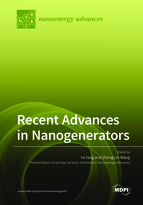Recent Advances in Nanogenerators
A special issue of Nanoenergy Advances (ISSN 2673-706X).
Deadline for manuscript submissions: closed (31 December 2021) | Viewed by 61327
Special Issue Editors
Interests: ferroelectric nanomaterials and devices; hybridizd and coupled nanogenerators; self-powered sensors; other energy-scavenging devices
Special Issues, Collections and Topics in MDPI journals
Interests: piezoelectric/triboelectric nanogenerators; triboelectric mechanisms and piezoelectric (photo)electronics; other applied fundamentals; functional devices; integrated systems research
Special Issues, Collections and Topics in MDPI journals
Special Issue Information
Dear Colleagues,
Converting nano-energies in our surroundings is essential to meet the challenges that we are facing in the Internet-of-things era. As a result, various types of nanogenerators have been developed to scavenge energies that are produced in the surrounding environment. Nanogenerators are based on using the Wang term ∂Ps/∂t as the driving force for converting mechanical energy into electricity regardless of whether nanomaterials are utilized or not. In 2006, piezoelectric nanogenerators were first reported, where zinc oxide nanowires were utilized to convert the mechanical energy from an atomic force microscope tip into electricity. In 2012, nanogenerators were further expanded to triboelectric nanogenerators, where PET and Kapton films were applied to construct the nanogenerator for converting mechanical energy from a linear motor. Since then, nanogenerators have been blossoming and the number of publications about nanogenerators has been increasing exponentially. Moreover, hybridized and coupled nanogenerators have been extensively reported; they can enhance the energy conversion efficiency and exhibit some special advantages over individual nanogenerators. For example, the hybridized electromagnetic–triboelectric nanogenerator can obtain more electric energy from one mechanical motion than an individual electromagnetic generator or triboelectric nanogenerator. Coupled nanogenerators exhibit one material, some electrodes, but different energy-scavenging functions and have a smaller size and higher performance than integrated nanogenerators. Pyroelectric and thermoelectric nanogenerators can be utilized to harvest thermal energy. The pyroelectric nanogenerator is based on the change in temperature with time, whereas the thermoelectric nanogenerator is based on the change in temperature across the device. Hence, this Special Issue of Nanoenergy Advances will report research and review articles to promote the development of nanogenerators.
Prof. Dr. Ya Yang
Prof. Dr. Zhong Lin Wang
Guest Editors
Manuscript Submission Information
Manuscripts should be submitted online at www.mdpi.com by registering and logging in to this website. Once you are registered, click here to go to the submission form. Manuscripts can be submitted until the deadline. All submissions that pass pre-check are peer-reviewed. Accepted papers will be published continuously in the journal (as soon as accepted) and will be listed together on the special issue website. Research articles, review articles as well as short communications are invited. For planned papers, a title and short abstract (about 100 words) can be sent to the Editorial Office for announcement on this website.
Submitted manuscripts should not have been published previously, nor be under consideration for publication elsewhere (except conference proceedings papers). All manuscripts are thoroughly refereed through a single-blind peer-review process. A guide for authors and other relevant information for submission of manuscripts is available on the Instructions for Authors page. Nanoenergy Advances is an international peer-reviewed open access quarterly journal published by MDPI.
Please visit the Instructions for Authors page before submitting a manuscript. The Article Processing Charge (APC) for publication in this open access journal is 1000 CHF (Swiss Francs). Submitted papers should be well formatted and use good English. Authors may use MDPI's English editing service prior to publication or during author revisions.
Keywords
- Triboelectric nanogenerators
- Piezoelectric nanogenerators
- Hybridized nanogenerators
- Coupled nanogenerators
- Pyroelectric nanogenerators
- Thermoelectric nanogenerators





